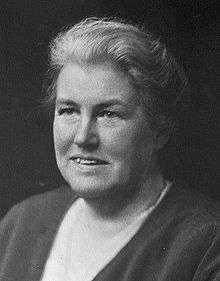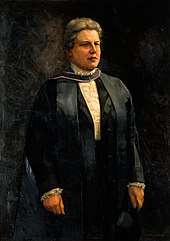Louisa Aldrich-Blake
Dame Louisa Brandreth Aldrich-Blake DBE (15 August 1865 – 28 December 1925)[1][2][3] was a pioneering surgeon and one of the first British women to enter the world of modern medicine. Born in Chingford, then a village in Essex, she was the eldest daughter of a curate. Louisa Aldrich-Blake graduated in medicine from the Royal Free Hospital in 1893. She obtained her Master of Surgery degree and was a lead surgeon by 1910.[3] Louisa volunteered for military medical service during the First World War. She was one of the first people to perform surgery on rectal and cervical cancers.[4] In recognition of her commitment and achievements, a statue was erected in Tavistock Square, London. This statue's position is close to her alma mater.[4]
Louisa Aldrich-Blake DBE | |
|---|---|
 | |
| Born | Louisa Brandreth Aldrich-Blake 15 August 1865 |
| Died | 28 December 1925 (aged 60) |
| Nationality | English |
| Occupation | Surgeon |
Early life and education
Louisa Aldrich-Blake was born in Chingford, Essex to Rev Frederick James Aldrich-Blake and his wife Louisa Blake Morrison.[3][5] She moved with her family to Welsh Bicknor in Herefordshire during her childhood, and maintained a home in the town until her death. Throughout her career, Aldrich-Blake was associated with the Elizabeth Garrett Anderson Hospital,[3] becoming senior surgeon in 1910.
Aldrich-Blake began her school education at Cheltenham Ladies' College. She graduated with first-class honours from the London School of Medicine for Women by 1894 as a Bachelor of Science, Bachelor of Medicine and an MD. Ongraduating from the University of London Aldrich-Blake followed with a masters in surgery a year later.[4] She went on to take the University of London's higher degrees in Medicine and Surgery, becoming the first British woman to obtain the degree of Master of Surgery.[6]
Career

The newly qualified Aldrich-Blake began work at the New Hospital for Women and Children in London. She worked her way up to become the lead surgeon while also working at the city's Royal Free Hospital.[4] At the Royal Free Hospital, she was the first woman to hold the post of surgical registrar in 1895 and also acted as an anaesthetist. Her position as consulting surgeon at the Royal Free started in 1919 and ended when she died in 1925. She also worked at the Canning Town Women's Settlement Hospital.[4]
During the First World War, many of the male surgical staff were deployed on foreign active service and Dr. Aldrich-Blake took on increased responsibility for the surgery, becoming consulting surgeon to the hospital. Aldrich-Blake spent multiple holidays aiding the military hospitals in 1914 to 1916, specifically in France with Dr. Frances Ivens from the Anglo-French Red Cross Hospital and helped out as a visiting surgeon at the Women's Army Auxiliary Corps Hospital.[3] Aldrich-Blake was nicknamed "Madame la Générale" by her patients. Her time was also spent contacting other women in the profession to organise volunteer units.[4] She approached every woman on the Medical Register to ask if they would consider volunteering for the Royal Army Medical Corps, and 48 enrolled, many of whom were sent to Malta.[7]
Aldrich-Blake was the first to perform operations for cervical and rectal cancers. She led the British surgeons in taking on the Wertheim operation for carcinoma of the cervix.[4] Aldrich-Blake added a piece to the Practitioner's Encyclopedia of Midwifery and Diseases of Women named "Pain as a symptom of pelvic trouble" and a piece on "Abdomino-perineal excision of the rectum by a new method" in the British Medical Journal in 1903.[8] She held a chair position as a vice-president of the Section of Obstetrics and Gynaecology in 1924 that was a part of the British Medical Association.
Although she had a professional practice, Aldrich-Blake never received a sizeable salary for her work.
Academia
Aldrich-Blake was devoted to training students at her alma mater, the London School of Medicine for Women (now the medical school of University College London).[6] She became Vice-Dean in 1906 and Dean of the School in 1914.[3] Aldrich-Blake's encouragement for women to join the medical field increased the school's population by almost double during the First World War.[3]
Death and legacy
Aldrich-Blake died on 28 December 1925 from cancer at home having undergone several operations during previous weeks. St Pancras Church, in London, celebrated her life on 1 January 1926 and her ashes were transferred back to her home in Welsh Bicknor.[3]

The Dame Louisa Brandreth Aldrich-Blake Collection is located in the Royal Free Hospital's Archives Centre. A statue of her is in Tavistock Square, London.[4] Her career was highlighted in a 2015 exhibit specifically related to her actions in the First World War where she performed surgery on the front line and encouraged other women to join the field. She also influenced the War Office to allow women to enlist to be a part of the medical staff.[9] In 2019, she was acknowledged with a Google Doodle for the UK, Ireland, Canada, Australia, New Zealand, Israel, Bulgaria, Sweden, Denmark, Estonia, and Iceland on the 154th anniversary of her birth.[10][11]
Awards and honours
In the year of her death, Aldrich-Blake was named a Dame Commander of the Order of the British Empire on the New Year's Honours List in 1925.[1][12]
References
- Staff (30 December 1925). "Distinguished woman surgeon. Death of Dame Louisa Aldrich-Blake". Gloucester Citizen – via The British Newspaper Archive.
- Staff (8 March 1926). "Dame Louisa Aldrich-Blake's Will". Gloucester Citizen – via The British Newspaper Archive.
- "Blake, Dame Louisa Brandreth Aldrich-". 2004. doi:10.1093/ref:odnb/30367. Cite journal requires
|journal=(help) - "Women in medicine: Wendy Reid and Louisa Aldrich-Blake". RCP London. Royal College of Physicians. 3 October 2017. Retrieved 24 April 2018.
- "Baptism Register for Chingford". Baptism Register for Chingford 1860–1866, WF/C83/2 RBp 2, p. 96.
- "Louisa Aldrich-Blake". University of London. Retrieved 15 August 2019.
- Brock, Claire (2017). British women surgeons and their patients, 1860–1918. Cambridge, UK: Cambridge University Press. pp. 258–260. ISBN 978-1316911921. OCLC 978293838.
- "Louisa Aldrich-Blake, D.B.E., M.D., M.S., Dean of the London School of Medicine for Women". The British Medical Journal. 1 (3393): 69–71. 1926. doi:10.1136/bmj.1.3393.69. JSTOR 25447393. PMC 2522579. PMID 20772293.
- "Dame Louisa Aldrich-Blake: Britain's First Female Surgeon". Science Museum Blog. Retrieved 24 April 2018.
- "Louisa Aldrich-Blake's 154th Birthday Google Doodle". Retrieved 15 August 2019.
- Doodles Archive: Louisa Aldrich-Blake’s 154th Birthday, Google, 15 August 2019, retrieved 15 August 2019
- "Page 6 | Supplement 33007, 30 December 1924 | London Gazette | The Gazette".